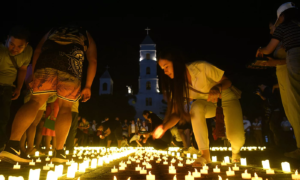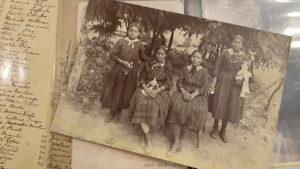When T’Challa steps into the purple-hued ancestral plane in “Black Panther,” standing before generations of Wakandan rulers, he embodies a connection to ancestors that resonates across cultures. Disney’s “Coco” captures this too, as Miguel discovers his family’s history through the glowing marigold bridges of Día de los Muertos. Even Simba’s profound moment with his father’s spirit in “The Lion King,” where Mufasa reminds him “you are more than what you have become,” speaks to a deeper truth: ancestral veneration isn’t a creation from Disney movies, but rather a traditional and spiritual practice spanning cultures.
As Americans increasingly seek connection to their cultural heritage — with ancestry-tracking services reporting record growth and millions of TikTok usersimagine conversations with their ancestors through viral videos — many BIPOC individuals are turning to traditional practices of ancestor veneration.
Building altars dedicated to ancestors is essential to honoring and building connection for practitioners of ancestral veneration. Darcell Andre, a holistic interventionist and a hoodoo practitioner in San Antonio, says the intention is to honor those who continue to guide the living.
“Even when we talk about people passing away, truly in Black American spirituality or African spirituality, it is not really a death that happens. It is just a transition. So the physical form is now in the spiritual form,” said Andre.

Andre emphasizes that practitioners aren’t worshiping their ancestors, but rather communing with them.
“I know that my grandmother is helping me through life. In the same way that I would say thank you to my grandmother if she was living, this is why I put down her cup of coffee. This is why I go and I make her favorite food and put it down as an acknowledgement,” he said.
While the word ancestor, as defined by Merriam-Webster, traditionally refers to family members who’ve died, Andre notes a common misconception about ancestors being limited to bloodline, adding that honoring adopted relatives is just as legitimate.
Christa Lei, a community care facilitator and death doula, started building an ancestor altar during the COVID-19 pandemic, basing some elements on altars their Filipino immigrant parents kept, and blending those traditions with their own beliefs, including activists who fought for issues essential to their identity.
“They’re not technically family or blood-related but Stacey Milbern, who is a disability advocate and queer, died over the pandemic. Because I’m disabled and chronically ill, that’s an ancestor to me, you know? Marsha P. Johnson, I’m queer, she’s also an ancestor,” said Lei, who uses they/she pronouns.
Crystal Dorado has operated her holistic wellness studio, Verde, in Chicago’s historic Pilsen neighborhood for 13 years. Though Pilsen has faced gentrificationfor two decades, it remains predominantly Latinos, specifically Mexican immigrants like Dorado’s grandfather, who was a curandero, or traditional folk healer, and grandmother who was a yerbera, or herbalist. She continues to teach and help others heal in the community she grew up in because of lessons from her father, who believed they could make an impact in their own community.
“[He taught me that] we didn’t need any kind of savior, we could do it ourselves,” Dorado told Reckon.
Building an altar came naturally to Dorado, who grew up in a spiritual household. Her family’s devotion ran deep—Dorado’s grandmother even had a church pew built in her home to kneel before her altar.
“They’ve always been a big part of my life. And altars, I think, really come from our indigenous ancestors and I think, this is not just for us specifically in our Mesoamerican ancestry, but also around the world,” she said.
Dorado believes maintaining a connection to ancestors keeps people grounded, which is especially crucial for BIPOC individuals navigating cultural identity in a society that often misrepresents their history.
“It allows the foundation not to be easily rocked. I think when we don’t know where we come from and who we are, we’re easily rocked off our axis,” she said. “Especially as minorities, we’re so manipulated by the media to believe these horrible aspects about ourselves, but they don’t speak about the truth about our ancestors. They were colonized. Our lands were stolen. They were hyper intelligent people.”
Reclaiming history and practices
Luis Cornejo (he/they), a licensed marriage and family therapist, co-owner of Psychosocial Therapy and host of the Queer Magic Podcast, was raised in a Christian Evangelist household. He found implementing an ancestral altar helped him embrace his Guatemalan and Mexican roots and reclaim his heritage.
“It was almost an opportunity to celebrate and honor people that were passing rather than just forgetting them,” said Cornejo. “Even in our religion we were often told when people pass like ‘they’re gone, let’s hope they’re in heaven,’ but there was never really any celebration or or honoring of the dead. I think it was more avoided than anything.”Luis Cornejo views their altar as a space to connect with loved ones and and express their creativity through the items and colors they place.Luis Cornejo
Connecting to their ancestors through veneration opened access to history for Conejo, who notes many BIPOC individuals and immigrant families’ trauma is a prominent aspect of their history, often preventing traditionals and knowledge from being passed down.
“A lot of times, what we do get is a reminder of the trauma that we have experienced as a family, whether it’s separation, whether it be first generation, whether it is growing up without our parents or whether it was domestic violence or alcoholism, it’s difficult for so many of our family members to process that it kind of almost stays there,” said Cornejo.
A 2017 Pew Research Center study found a weakening Latino identity through generations. As more Latinos marry non-Latinos, some born in the U.S. lose connection with their heritage. About 11% of Latinos—5 million no longer identified as Hispanic or Latino, particularly in the third generation or later.
Dorado says connecting with ancestors can help alleviate intergenerational trauma and prevent it from continuing down the lineage.
“When we do generational healing, and when we change the narrative, we not just change it for the past, but we also change it for the future generations. They will no longer live the same narratives that we inherited from our grandparents. You know, they will no longer live the sense of oppression, the sense of loss, or that sense of not being able to accomplish,” she said.
Creating your own altar
How you build an altar is a personal choice, but the most basic elements of an altar are a cloth covered surface, glass of water, food offering and photo of a deceased loved one, if you have it.
While flowers and candles provide a good starting point, an altar can be as simple as a rock or leaf you find outside.
“It could start with a vase of flowers and a picture of someone you love. It could start with a statue of a deity and a candle. And then as you go on and you collect, your altar will grow and you will find things that are more important to you,” said Dorado. “It’s very important that it’s personal.”
Dorado, who studied under Mayan healers in Yucatan, Mexico, was taught that the oldest ancestors are the elements: air, fire, water, and earth. Andre and Dorado consider it important to keep the four elements, represented by a candle to represent fire, incense to represent air, a glass of water, and various objects for earth.
“I make sure that my altar has a lot of crystals in it, because that is earth energy more than anything,” said Dorado, adding that she intentionally taps into earth energy to reclaim connection to her Indigenous ancestors, historically severed from Mexicans and Mexican Americans through colonization and assimilation.
Food remains a common offering across cultures, including Chinese, Mexican, Hindu traditions, and more.
“At family parties, someone always made a full plate of food for the ancestors who have gone, and then we leave it on an altar,” said Lei. “That’s an offering that is for them that’s kind of like a simple thing to give them.”Christa Lei’s ancestor altar is a focal point of their living room. They told Reckon that including plants has helped ensure they spend time at their altar regularly.Christa Lei
Dorado says food remains prominent because it represents a connection to life.
“Even though life can be bitter and hard, there’s always sweetness in it,” she said.
While most practitioners place altars on a shelf or table, Andre notes location depends on the space available.
“Sometimes you will see people have ancestor altars in drawers because they can just close it up or they’ll put in like a shoe box and they’ll pray with their ancestors, or speak to their ancestors, or communicate with their ancestors through divination tools, like cards or a pendulum,” said Andre. These discrete practices mirror those of historically enslaved Africans who practiced Yoruba religions and Indigenous Americans, both forced to practice Christianity.
Andre emphasizes that veneration extends beyond a physical space, through funerals, placing flowers on graves, passing down namesakes, or singing favorite songs.
“We all do it. We have been doing it. The only thing that has occurred is religious indoctrination and cultural erasure has happened,” said Andre.
Cornejo advises against feeling pressure to match a certain aesthetic or match pictures of the grand Dia de los Muertos ofrendas, or altars, that circulate on social media.
“It doesn’t have to look or be a certain way. I made it something that’s very personal to me where I include things that I’ve kind of collected over the year,” said Cornejo, naming their dog’s ashes, a pinata, and dolls as some of the other items they keep on their altar.
Ultimately, altars center on intention and shouldn’t be a homework assignment, according to Dorado who says your ancestors just want to spend time with you.
“Spirit is just happy for your connection and your reverence and your moment for yourself,” she said.
If you purchase a product or register for an account through a link on our site, we may receive compensation. By using this site, you consent to our User Agreement and agree that your clicks, interactions, and personal information may be collected, recorded, and/or stored by us and social media and other third-party partners in accordance with our Privacy Policy.




